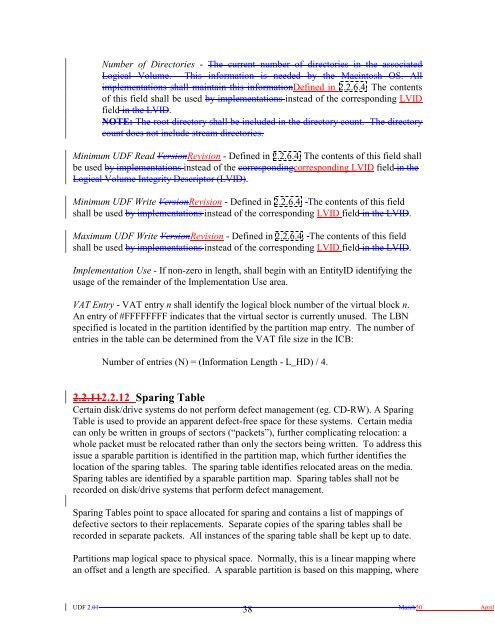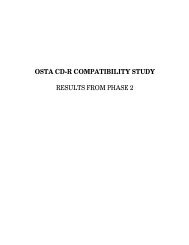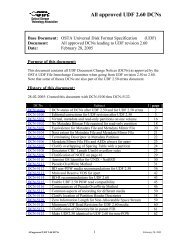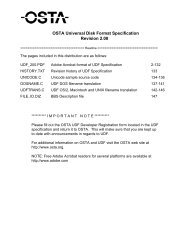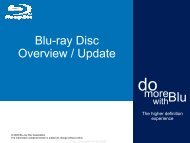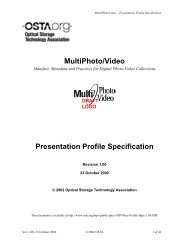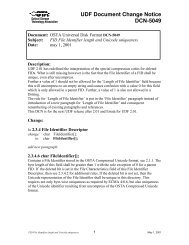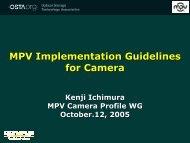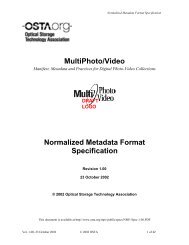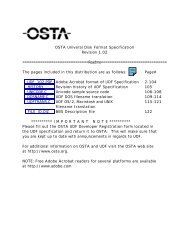here - OSTA - Optical Storage Technology Association
here - OSTA - Optical Storage Technology Association
here - OSTA - Optical Storage Technology Association
Create successful ePaper yourself
Turn your PDF publications into a flip-book with our unique Google optimized e-Paper software.
Number of Directories - The current number of directories in the associated<br />
Logical Volume. This information is needed by the Macintosh OS. All<br />
implementations shall maintain this informationDefined in 2.2.6.4. The contents<br />
of this field shall be used by implementations instead of the corresponding LVID<br />
field in the LVID.<br />
NOTE: The root directory shall be included in the directory count. The directory<br />
count does not include stream directories.<br />
Minimum UDF Read VersionRevision - Defined in 2.2.6.4. The contents of this field shall<br />
be used by implementations instead of the correspondingcorresponding LVID field in the<br />
Logical Volume Integrity Descriptor (LVID).<br />
Minimum UDF Write VersionRevision - Defined in 2.2.6.4. The contents of this field<br />
shall be used by implementations instead of the corresponding LVID field in the LVID.<br />
Maximum UDF Write VersionRevision - Defined in 2.2.6.4. The contents of this field<br />
shall be used by implementations instead of the corresponding LVID field in the LVID.<br />
Implementation Use - If non-zero in length, shall begin with an EntityID identifying the<br />
usage of the remainder of the Implementation Use area.<br />
VAT Entry - VAT entry n shall identify the logical block number of the virtual block n.<br />
An entry of #FFFFFFFF indicates that the virtual sector is currently unused. The LBN<br />
specified is located in the partition identified by the partition map entry. The number of<br />
entries in the table can be determined from the VAT file size in the ICB:<br />
Number of entries (N) = (Information Length - L_HD) / 4.<br />
2.2.112.2.12 Sparing Table<br />
Certain disk/drive systems do not perform defect management (eg. CD-RW). A Sparing<br />
Table is used to provide an apparent defect-free space for these systems. Certain media<br />
can only be written in groups of sectors (“packets”), further complicating relocation: a<br />
whole packet must be relocated rather than only the sectors being written. To address this<br />
issue a sparable partition is identified in the partition map, which further identifies the<br />
location of the sparing tables. The sparing table identifies relocated areas on the media.<br />
Sparing tables are identified by a sparable partition map. Sparing tables shall not be<br />
recorded on disk/drive systems that perform defect management.<br />
Sparing Tables point to space allocated for sparing and contains a list of mappings of<br />
defective sectors to their replacements. Separate copies of the sparing tables shall be<br />
recorded in separate packets. All instances of the sparing table shall be kept up to date.<br />
Partitions map logical space to physical space. Normally, this is a linear mapping w<strong>here</strong><br />
an offset and a length are specified. A sparable partition is based on this mapping, w<strong>here</strong><br />
UDF 2.01<br />
38<br />
March50 April


